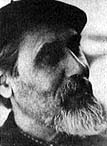DURAY, Tibor
(1912, Budapest - 1988, Budapest)


Painter, graphic artist and sculptor, winner of the Munkácsy Prize (1969). Between 1933 and 1936 he studied at Vilmos Aba-Novák's independent school. From 1936 he started appearing as an exhibitor. In 1937 and 1938 he worked as a scholar in Rome, the Székely land (eastern Transylvania); in 1947 and 1948 in Paris. From 1941 he also dealt with sculpting. In 1945 his attention was focused on glass painting. In 1946 he was awarded the Graphic Art Prize of the Szinyei Society. From 1949 he was teaching figure drawing at the School of Applied Arts for three years. His monumental painting suggests resemblance with German impressionism, but it was also affected by the art of El Greco, Gyula Derkovits and Picasso. In his sombre-toned, dramatically expressive, vision-type pictures elements of reality are augmented into symbols.
In the first part of his artistic career, besides his portraits, the principal theme of his works is the world of workmen, the poor, the deprived (Blind Boy, 1934). During his stay in Paris he was influenced by cubism and constructivism (Fishergirl, 1948), but his inner passion and attraction to the tragic consummated in expressionism. He painted 'Silent Trees' and 'Refugees' in 1941. His war experiences were captured in apocalyptic visions (e.g. The Foundered Horse, The Helpless, Christ with Thorns; 1944). His symbols often originate in Christian symbolism. His timber panel entitled Memento (1967) conveying a breathtaking atmosphere reminiscent of the mood of Golden Age and Guernica was presented at his retrospective exhibition. His adroit skills in shape representation and drawing technique are substantiated by a number of his graphic sequels (e.g. the washes made in the time of his sojourn in Transylvania). His monumental small plastics and medals pertain to classical patterns of the genre.
He won a prize at the second and third exhibitions of the Sopron National Medal Biennial (1979, 1981). He produced a number of murals to state order. Several of his paintings and graphics and medals can be found in the Hungarian National Gallery (Self-portrait, 1937; Sleeping Family, 1937; Sleeping Woman, 1937; Tragic Face, 1947; Don Quixote, 1944). In 1964 the Hungarian Television made his film profile.
